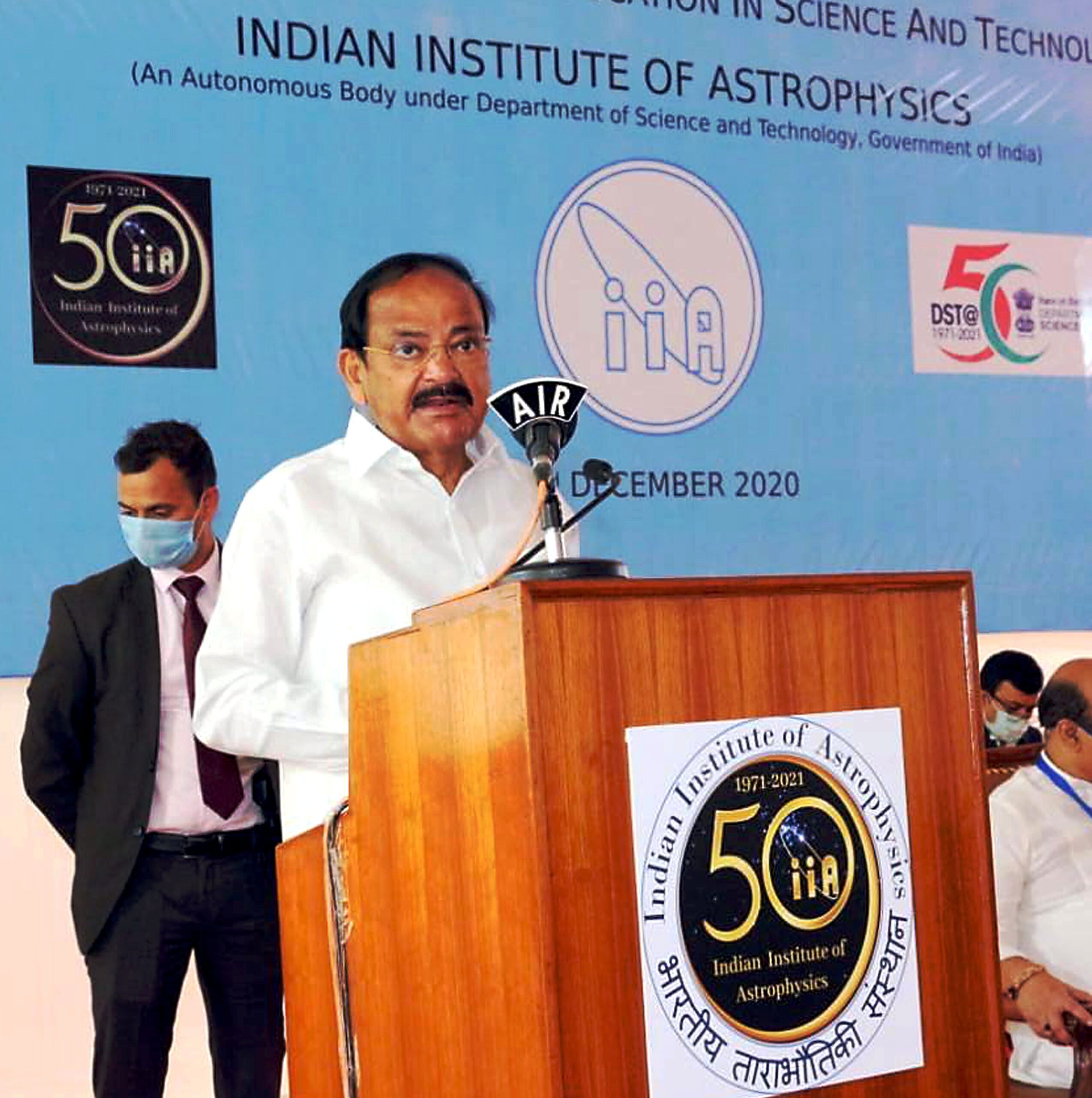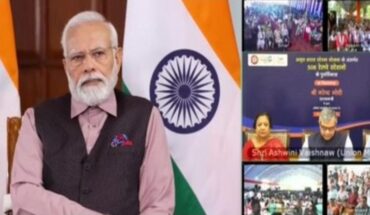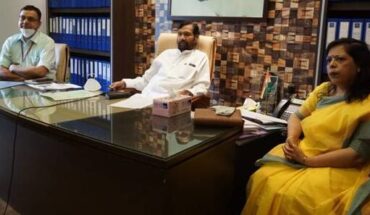By Dominick Rodrigues/Arunkumar Rao
Bengaluru, : Vice-President Venkaiah Naidu today lauded the Indian scientists’ contribution and commitment — to basic astronomy research and technology development for future generations – as the foundation for an ‘Atmanirbhar Bharat.’ The Department of Science & Technology and the Indian Institute of Astrophysics are celebrating 50 years of service to the nation.
Addressing a gathering at the Centre for Research and Education in Science and Technology of Indian Institute of Astrophysics, Bengaluru, the Vice-President described the environmental test facility– that was inaugurated today — as a facility to qualify small space payloads, while also fabricating optics for a 30-metre Telescope in Hawaii, USA..
“This will be opened for use by universities and industry to develop small space payloads, while also helping growth of space sector in the future. India’s foray into such global and world class national scientific ventures seems natural, given its intellectual reserves and global stature as an emerging economic and political power. It is important to inculcate scientific thinking in the younger generation, and Institutes like this should be able to provide a platform for innovations and technological advancements,” he said.
While India’s participation in mega-science projects provided the science community a unique opportunity to stand shoulder to shoulder with other advanced nations in the planning and construction of these complex projects, they also brought the ambitious science experiments and industry together — thus benefiting the country in capacity building and technology transfer, he added.
Expressing pride in the Department of Science & Technology and also the Indian Institute of Astrophysics celebrating 50 years service to the nation, he said “Astronomy benefitted society through technology transfer into industrial, aerospace, and energy sectors like x-ray machines, precision clocks, super computers, satellite communication, GPS etc. Astronomical studies are also helping us understand the evolution and composition of Earth’s atmosphere, besides providing vital insights into climate change and related solutions, and uniting people and nations in several international projects.”
“The Indian Institute of Astrophysics has a long history in pursuing astronomical research, and has contributed richly to scientific knowledge. Some of the major discoveries include the presence of element Helium in the Sun and rings around the planet Uranus. This Institute also operates a solar observatory in Kodaikanal, which was part of Madras Observatory set-up in 1786, and maintains data of continuous observations of the Sun for about 120 years –a treasure trove of solar studies.”
“IIA also operates the Indian Astronomical Observatory (IAO), Hanle, Ladakh — one of the highest altitude observatories in the world at about 4500-meter above sea level. Science is the foundation of any society as it deals with truths of verifiable facts through repeated experiments. Inculcating scientific temperament among the society is key for the progress of societies and sustaining humanity.”
Naidu also highlighted India’s long tradition of Astronomy and notable contributions to the world of astronomy from ancient times to modern era, including Aryabhatta of 5th Century CE being a well known mathematician and astronomer, whose pioneering works include rotation of earth and motions of planets around the Sun etc.
“Indian contributions in modern astronomy have been truly outstanding and long-lasting.
Astrophysicist Meghnad Saha formulated the well-known Saha equation that determines the temperature of various kinds of stars by using spectral line intensities of different elements, and which is one of the most fundamental works much of current stellar atmospheric studies stand upon. Another reputed astrophysicist is Subramanyan Chandrashekar whose works on stellar structure won him the Nobel Prize in 1988. To recognize and honour his contributions to astronomy and astrophysics, NASA named one of its most prestigious and multi-billion dollar space telescopes as Chandra X-ray Telescope.”
“Prof. Vainu Bappu, father of modern optical and infrared astronomy in India, was responsible for building the indigenous 2.3 meter telescope, which was one of the largest in the world at that time and the largest in Asia. India recently commissioned a 3.6 meter Devasthal Optical Telescope in 2015, which, at present, is the largest optical telescope in the country.”
While the global astronomy community has access to 10-meter-class telescopes over past two decades with plans for building next generation observatories, this required huge financial and human resources — necessitating international partnerships, Naidu said, adding, “In 2014, the Cabinet chaired by Prime Minister Narendra Modi approved India joining Japan, China, Canada and USA to build a 30-metre Telescope in Hawaii, USA. It gives me great pleasure to inaugurate the facility that will fabricate optics for realization of this international endeavor.”
Noting that participation in such mega scientific projects provided a level playing field for Indian scientists while helping industries build capacity in high technology field and
India to move up in the technology front very rapidly, he said the much-talked-about ISRO space mission “Mangalyan,” India’s astronomy observatory “ASTROSAT (astronomy satellite) for surveying the sky in X-ray and UV, and the soon-to–be launched Aditya L1, a solar study mission, are a few examples including the Aditya mission, which will be placed in space nearly 15 lakh kilometers from the Earth, and will enable an unprecedented close look at our star — the Sun.






